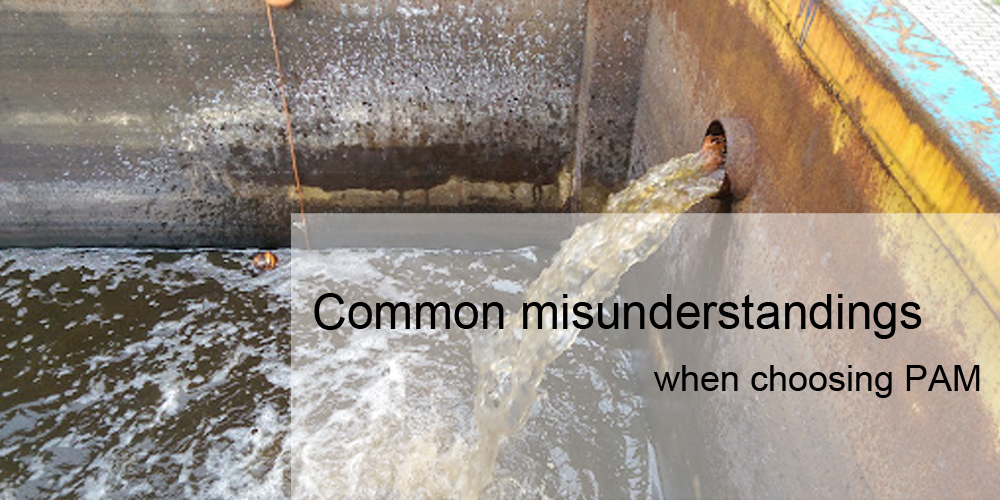Polyacrylamide(PAM), seinowanzo shandiswa polymer flocculant, inoshandiswa zvakanyanya munzvimbo dzakasiyana siyana dzekuchenesa tsvina. Nekudaro, vashandisi vazhinji vakawira mune kumwe kusanzwisisana panguva yekusarudza uye kushandisa maitiro. Ichi chinyorwa chine chinangwa chekuburitsa kusanzwisisa uku uye kupa kunzwisisa kwakaringana nemazano.
Kusanzwisisa 1: Kukura kwehuremu hwema molecular, ndiko kukwira kweiyo flocculation inoshanda.
Pakusarudza polyacrylamide, vanhu vazhinji vanofunga kuti modhi ine hombe yemamorekuru huremu inofanirwa kuve nepamusoro flocculation kunyatsoshanda. Asi chaizvoizvo, kune mazana emhando dzepolyacrylamide, iyo inokodzera mamiriro akasiyana emvura. Hunhu hwemvura yetsvina inogadzirwa nemafekitari mumaindasitiri akasiyana akasiyana. Iyo pH kukosha uye chaiyo kusvibiswa kwemhando dzakasiyana dzemvura zvakasiyana zvakanyanya. Vanogona kunge vane acidic, alkaline, neutral, kana kuti vane mafuta, organic matter, color, sediment, etc. Nokudaro, zvakaoma kune imwe mhando ye polyacrylamide kusangana nezvose zvinodiwa zvekuchenesa mvura. Nzira chaiyo ndeyekutanga kusarudza modhi kuburikidza nekuedza, uyezve kuita bvunzo dzemuchina kuti uone iyo yakakwana dosage kuti uwane iyo inodhura-inoshanda mhedzisiro.
Kusanzwisisa 2: Iyo yakakwirira iyo yekumisikidza yekumisikidza, zviri nani
Paunenge uchigadzira mhinduro dzepolyacrylamide, vashandisi vazhinji vanotenda kuti iyo yakakwira yekumisikidza, inova nani iyo flocculation zvivakwa. Zvisinei, maonero aya haana kururama. Muchokwadi, iyo yekumisikidzwa kwePAM kumisikidzwa kunofanirwa kutariswa zvinoenderana neiyo chaiyo sewage uye sludge mamiriro. Kazhinji kutaura, mhinduro dzePAM dzine huwandu hwe0.1% -0.3% dzakakodzera kuyerera uye sedimentation, ukuwo kusungirirwa kwemanisiparati nemaindasitiri sludge dewatering iri 0.2% -0.5%. Kana pane tsvina yakawandisa mumvura yetsvina, kusungirirwa kwePAM kungada kuwedzerwa zvakakodzera. Naizvozvo, iyo inonzwisisika yekumisikidza yekumisikidza inofanirwa kutariswa kuburikidza nekuyedza isati yashandiswa kuve nechokwadi chekushandisa kwakanakisa.
Kusanzwisisa 3: Kurebesa nguva yekunyungudika nekukuchidzira, zviri nani
Polyacrylamide ichena crystalline particle inoda kunyungudutswa zvizere kuti iwane yakanakisa mhedzisiro. Vazhinji vashandisi vanofunga kuti iyo yakareba nguva yekunyungudika uye yekukurudzira, zviri nani, asi muchokwadi izvi handizvo. Kana iyo nguva yekukurudzira yakarebesa, inokonzeresa kutsemuka kwePAM molecular chain uye kukanganisa flocculation performance. Kazhinji kutaura, nguva yekunyungudika uye yekukurudzira haifanirwe kunge iri pasi pemaminitsi makumi matatu uye inofanira kuwedzerwa zvakakodzera kana tembiricha yadzikira muchando. Kana kuparara uye nguva inokurudzira ipfupi, PAM haizove yakanyungudika zvakakwana, izvo zvichaita kuti kusakwanisa kuita zvinobudirira kukurumidza flocculation mutsvina. Naizvozvo, vashandisi vanofanirwa kuve nechokwadi chekuparara kwakakwana uye nguva yekukurudzira kana uchiishandisa kuve nechokwadi chekuyerera kwePAM.
Kusanzwisisa 4: Ionicity / Ionic degree ndiyo chete hwaro hwekusarudzwa
Sechimwe chezviratidzo zvakakosha zvepolyacrylamide, ionicity inoreva kushaja kweiyoni yakaipa uye yakanaka uye huwandu hwayo hwekuchaja. Vanhu vazhinji vanonyanya kutarisisa kune ionicity pavanenge vachitenga, vachifunga kuti iyo yakakwirira iri nani. Asi kutaura zvazviri, dhigirii reionic rine hukama nehukuru hwehuremu hwemamorekuru. Iyo yakakwirira iyo ionicity, idiki huremu hwema molecular, uye inokwira mutengo. Muchisarudzo chekusarudza, kuwedzera kune ionicity, zvimwe zvinhu zvinoda kutariswa, zvakadai semamiriro chaiwo ehutano hwemvura, zvinodiwa zve flocculation effect, nezvimwewo. Kumwe kuedzwa kunodiwa kuti uone modhi inodiwa.
Sezvo aflocculant, polyacrylamide inoita basa rakakosha muindasitiri yekurapa mvura. Paunenge uchinge uchinge uchinge uchinge uchinge uchinge uchinge uchinge uchinge uchinge uchinge uchinge uchinge uchinge uchinge uchinge uchinge uchinge uchinge uchinge uchinge uchinge uchinge uchinge uchinge uchinge uchinge uchinge uchinge uchinge uchinge uchinge uchinge uchinge uchinge uchinge uchinge uchida kundibata.
Nguva yekutumira: Aug-26-2024


